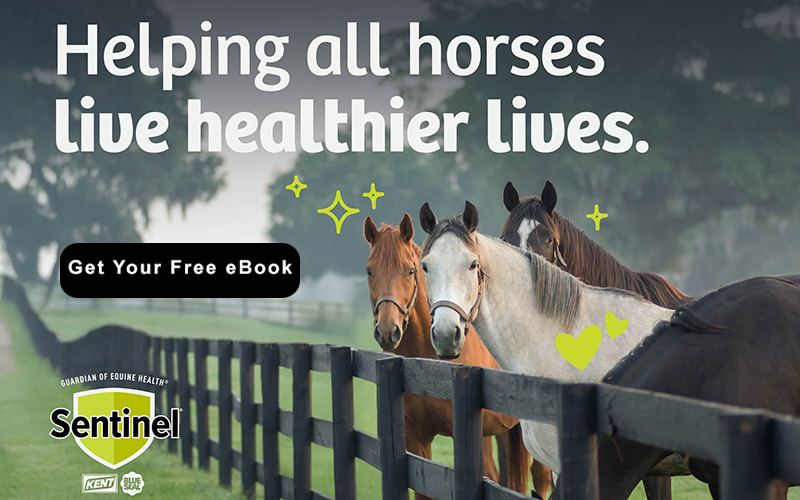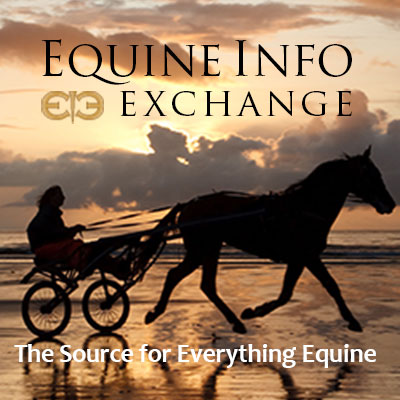Health & Education
We all want the best care possible for our horses. The Heath & Education section covers both Learning Institutions, Organizations as well as many sources for equine assistance including Veterinarians and Farriers.
For those who want a to formally study horses, the Education section includes College Riding, Equine Studies, and Veterinary Schools. Learn about the wide variety of horses in the Horse Breeds section. Supplements and Treatments Therapy are also included in the section.
Everyone can learn from Fine Art and there are some specialty Museums that might surprise you.
Horses as a therapy partner enrich the lives of the disabled. These facilities are listed in our Therapeutic Riding section. To help children and young adults build confidence and grow emotionally, please see the resources available on the Youth Outreach page.
Looking for a place to keep your horse? You can find it in the Horse Boarding section. Traveling? Find a Shipping company or Horse Sitting service if your horse is staying home!
Want to stay up to date with the latest training clinics or professional conferences? Take a look at our Calendar of Events for Health & Education for the dates and locations of upcoming events.
Do we need to add more? Please use the useful feedback link and let us know!

We understand that blanketing horses can seem overwhelming. But take a deep breath, friends, we’re here to help simplify with this in-depth but simplified horse blanketing guide. Continue reading for understanding of reasons to blanket horses, different horse blanket types, sizing horse blankets, cleaning horse blankets, helpful tips and more!
First, Why Horses Are Blanketed
There are two main reasons horse owners blanket their horses and ponies:
- To keep horses sleek for the show ring
- To provide comfort during inclement weather conditions
Different Horse Blanket Types & When to Wear Each
There is much to consider when selecting a horse blanket, details such as age, body condition and coat thickness. Additionally, horses across the country experience a variety of climates, weather conditions and stabling environments. Luckily, just as your closet holds clothes tailored to the day and season, there are different types of horse blankets available, too, so you can select just what your horse needs when he needs it.
Let’s first look at a few horse blanketing basics -- sheets vs. blankets and turnout vs. stable. How familiar are you with the differences between each?
Sheets vs. Blankets
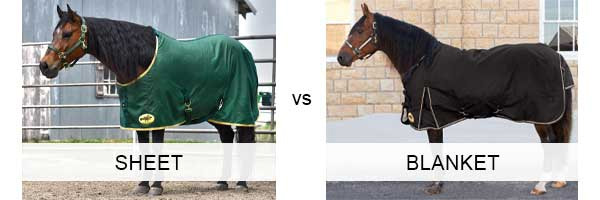
A horse sheet is lightweight and is perfect for those mildly cold or windy days. They have no fill.
A horse blanket offers fill, which is essentially a form of insulation sewn into the blanket to add warmth (think of your poufy winter coat!) The higher the fill number on a blanket, the cozier the pony on those cold days.
Turnout vs. Stable
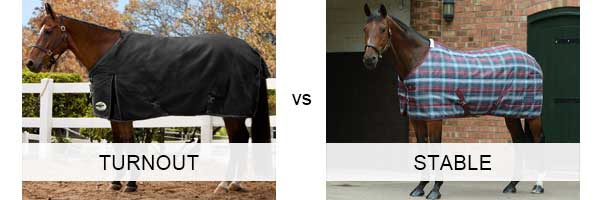
Sheets and blankets come in two varieties: turnout and stable. To put it simply, turnout sheets and turnout blankets are intended for horses at turnout. They will feature waterproof material to keep pasture ponies dry. Without waterproof technology, a wet horse blanket could only make your horse colder, which is of course not what was intended!
Stable sheets and stable blankets are ideal for horses kept inside a stable and are not made from waterproof material. They serve an important purpose by keeping stabled horses comfy, warm and sleek.
Understanding Warmth & Durability
When you are selecting a horse blanket, you will notice a few number sets under the product descriptions, noting denier and fill.
Denier denotes the durability of a horse blanket or sheet. It measures nylon fiber density on the outer material of horse blankets. Denier ranges from 70 to 2400D. The higher the denier, the more durable it is for those tough-on-blanket horses (you might have one or two in mind!)
As we shared earlier, fill is padding that adds an extra layer of warmth to your horse’s blanket. Both with denier and fill, the higher the number, the tougher or warmer the blanket’s material will be.
Do you know the degree of blanket warmth your pony needs and when? We put together this easy-to-reference chart to help as a guide!
| Weather Conditions | Grams of Fill |
|---|---|
| 50-60° | Sheet (0g) |
| 40-50° | Light blanket (100g) |
| 30-40° | Light or medium blanket (150 to 250g) |
| 20-30° | Medium or heavy blanket (200 to 300g) |
| Below 20° | Heavy blanket (300 to 400g) |
Measure your horse for a blanket or sheet

Did you know that wardrobe malfunctions happen to horses, too? It’s true! If a horse’s blanket or sheet isn’t properly fitted to him, it could slip off to the side, which could cause him to trip or tangle, possibly resulting in injury.
Learn how to measure a horse for a blanket with these quick and simple horse blanket sizing steps. When measuring your horse, start from the center of his chest and measure around the widest part of the shoulder, along the barrel and around the widest part of the hindquarter to the center of the tail. Keep your line horizontal to the ground. His blanket measurement will be the same as the number of inches measured. If the exact number of inches is not available to select from, size up to the nearest measurement.
5 Tips for the Perfect Horse Blanket Fit
Before buckling your horse’s new duds and sending him to the back field amuck, double-check your measurements to make sure the blanket is a perfect fit. First, put on the horse blanket, and check that:
- Fastened chest straps overlap slightly and fit snug but not too tight
- Surcingles fit loosely with about four fingers width between his stomach and the straps
- There is only one hand’s width between each leg strap on your horse’s thighs
- The end of the blanket stops just above where the tail starts
- Fabric is not pulling tightly against his shoulders or blanket hangs too low
Storing & Cleaning Horse Blankets
Properly storing and cleaning horse blankets and sheets will help them last.
You also can extend the life of your horse’s blanket by keeping it up off of the ground and away from opportunistic rodents who may look at your gorgeous new blanket as a home (or worse -- a snack!)
During the colder months, when you may appreciate quick access to your horse’s blankets, you can store blankets with blanket racks, which can hold several blankets at once, keeping tack rooms tidy and fluff-free. Or, you can look into individual solutions for blanket storage, such as a horse blanket wall rack to hang on your horse’s stall door or a blanket storage bag.
horse blanket rack

After your horse’s blankets have protected them from the rain, snow and the muck of cold weather, it’s time for a good cleaning. You can either opt for cleaning horse blankets yourself, or, you can send them to a blanket laundry service.
Cleaning horse blankets may be easier than you think! Just follow these steps.
3 Steps for Cleaning Horse Blankets
- Pre-wash - Use stiff brush to remove excess horse hair, mud and dirt. Hose off blanket, and hang to dry.
- Wash - Wash using a horse blanket detergent, such as Saddle Pad & Horse Blanket Wash by Absorbine.
- Dry - Hang horse blankets to dry in a shady area to avoid color deterioration of the material.
*Follow manufacturer’s cleaning instructions for best results.
Shop horse blankets for sale at Valley Vet Supply to ensure your horse is snug as a bug with a high-quality horse blanket or sheet that meets his specific needs.
All photographs and images courtesy of Valley Vet.
This article originally appeared on Valley Vet and is published here with permission. Valley Vet Supply was founded in 1985 by veterinarians for people just like you - people who want the very best for their four-legged friends and livestock.
There are more informative articles in our section on Health & Education.

Understand symptoms of choke in horses, and beware signs of choke in a horse.
When one sees their horse choking, it’s a cause for alarm and expedient action.
What does a horse choking look like?
In one instance, a 7-year-old Thoroughbred took just a few bites of alfalfa pellets, immediately retching to take a breath. The gelding coughed as gobs of fluid and feed distributed from his nostrils. At first, he was alarmed, then soon lethargy took over and he displayed pneumonia-like symptoms.
What are symptoms of choke in horses?
Symptoms can include feed material coming from the nostrils, hypersalivating, retching, coughing, and other signs similar to colic in horses, according to the American Association of Equine Practitioners (AAEP). This can be a dangerous condition -- one to take seriously.What causes choke in horses?
Most commonly, choke in horses is caused by eating concentrated feed too quickly. When the feed is not chewed up appropriately, it is not softened with saliva, according to AAEP, which details how “This forms a firm bolus that gets lodged in the esophagus.”
Forage like hay or alfalfa cubes are the most frequent cause of choke in horses. Choke in older horses, or horses with poor dental health, can be common. But any horse, no matter their age, is at risk. Tony Hawkins, DVM, Valley Vet Supply Technical Service Veterinarian recommends horse owners, “Soak the grain and forage-based pellets and cubes to help horses better chew it up and help them pass it down.”
What immediate steps should be taken for a horse choking?
- If you see a horse choking, and it’s not resolved on their own within 30 minutes, call your veterinarian to come out or haul them into the clinic if you have to. Always have a backup veterinarian/24-hour clinic in mind.
- Gently massage their throat beginning from the top, down.
- Remove access to food and water, as “both could predispose them to aspiration,” warns Dr. Hawkins.
- Choke can sometimes resolve on its own, as the saliva will break down the food matter so it can pass through. But again, follow the 30-minute rule above and phone a veterinarian if not passed through by that time.
- DO NOT:
- Attempt helping your horse pass the blockage yourself, using a garden hose. Doing so could puncture the esophagus. Accidentally worsening the situation, some horse owners pull up the horse's head to ‘help’ him pass a blockage. This only lodges it further.
What does treatment for choke in horses entail?
Treatment for esophageal choke in horses often requires that a veterinarian sedate the horse before passing a nasogastric tube to clear the obstruction, while simultaneously flushing with water to remove the lodged material. AAEP notes that a second approach may be used by veterinarians. Based on the theory that most chokes eventually self-cure, horses may receive several rounds of sedation, as the medications help to relax the esophageal muscles, coupled with fluids to keep the horse hydrated. Should treatment be too much delayed, horses risk dehydration, or death.
Beware the after effects of choke in horses.
AAEP describes how the after effects of choke in horses can be equally as dangerous as the choke itself, stating “Most importantly, chokes predispose horses to aspiration pneumonia, which is caused by feed material going down the trachea and into the lungs. This foreign material in the lungs can cause the horse to develop a secondary bacterial infection.” It’s not uncommon for veterinarians to prescribe antibiotics for your horse to help mitigate the risk.
After a choke episode, be sure to monitor your horse’s temperature for several days, recommends Dr. Hawkins. A fever is one of the first signs of pneumonia. Other symptoms include nasal discharge, coughing, and labored breathing and increased respiratory rate. Normal respiration rate in a horse is 10 to 14 breaths per minute.

By Juliet M. Getty, Ph.D.
It's easy to spend a fortune on the next fancy feed, supplement or gadget. Sure, there are plenty of worthwhile products that may very likely improve health and reverse illness, but none of them truly matter without meeting these five foundational principles. These are true for all horses, regardless of age, breed, condition, or purpose. Even seasonal or regional variations do not alter these.
Here is what every horse needs. Period.
Water - the most important nutrient
It must be plentiful, clean, and of the right temperature to encourage horses to drink. A horse at maintenance, living in a temperate climate will require a minimum of ½ to 1 gallon per hundred pounds of body weight. For the 1100 lb (500 kg) horse, that equates to 5.5 to 11 gallons (21 to 42 liters) per day. [i] However, his demand for water will increase with activity and warmer temperatures. Here are some factors to consider:
- Water must be freshened daily. Dead insects, bird droppings and excessive pond scum can poison your horse [ii]. Using smaller water troughs can make cleaning easier.
- Never add salt or electrolytes to your horse’s only water supply. Plain water must always be available.
- Pasture is high in moisture, typically containing 60 to 80 percent water, whereas most hays have only 7 to 10% moisture.
- High protein diets increase water requirements since protein can have a diuretic effect.
- During cold weather, horses drink less, especially if the water is ice cold. This potentially leads to dehydration – the main cause of colic in the winter. Heating water between 45 and 60 degrees F (7 to 15 degrees C) will promote more water consumption. Be sure the heater has no exposed wires that could electrify the water source.
- If you rely on creeks or ponds, the water must be moving and deep enough to not freeze.
- Snow consumption will not meet your horse’s water requirement. One gallon of average snow contains only 10 ounces of water. Also, eating snow will force your horse to burn precious calories needed to keep his body temperature steady.
Salt is required daily, regardless of the season
In cold seasons, salt helps promote that all-important water consumption. In warm seasons, supplemented salt replaces what is lost from perspiration. A full-sized horse requires at least one ounce (two level tablespoons or 30 ml) of salt each day for maintenance -- this much provides 12 grams of sodium. Heat, humidity, and exercise increase the horse’s need. There are several ways to accomplish this:
- Granulated salt can be offered free-choice. Check your source for prussic acid, an anti-caking agent. This contains cyanide and should be avoided.
- Mined sea salt offers many minute quantities of trace minerals that are typically not available in the average diet. [iii]
- A salt rock should be available should your horse want more. Experiment with different natural types to see what your horse enjoys most. Many horses, however, are not comfortable with constant licking.
- If salt consumption is too low via free-choice feeding, calculate the amount of sodium your horse is getting from any commercial feeds or supplements and add salt accordingly. (For palatability, limit the amount to no more than 1 tablespoon per meal.)
- Do not offer electrolyte supplements instead of plain salt. Electrolytes are meant to replace perspiration losses and fed in addition to salt. Never add electrolytes to your horses only water supply.
- Watch the iodine content in mineralized salt preparations. Too much iodine, and not enough selenium, can damage the thyroid gland. Iodine and selenium intakes need to be similar.
Forage is the foundation of the diet – it must flow through the digestive tract 24/7
Horses are grazing animals and are designed to consume forage virtually all day and night, only taking a few minutes here and there to rest; this also includes ponies, minis, donkeys, and mules. There are many reasons why your horse must always have hay and/or pasture:
- The horse’s stomach produces acid continuously, even when empty. The acid in an empty stomach can lead to the formation of ulcers anywhere along the gastrointestinal tract.
- The cecum, where fiber is fermented, has its entrance and exit at the top; therefore, it must be full in order to evacuate digested forage. If not, substances sink to the bottom, potentially leading to impactions and sand colic.
- The digestive tract consists of muscles which are “exercised” by the steady flow of forage. “Flabby” muscles can twist or intussuscept (telescope)—increasing the risk of colic.
- An empty stomach causes incredible stress, creating a hormonal response that raises insulin, an inflammatory hormone that can potentiate laminitis. Elevated insulin also tells the body to store fat.
- Stress from forage restriction can lead to obesity, a damaged metabolic rate, laminitis relapses, and inflammation of the hypothalamic region of the brain, accelerating the development of leptin resistance and even Cushing’s disease. [iv]
- Elevated stress also impacts immune function, making your horse more susceptible to infections and allergies, as well as negative reactions to vaccinations.
Don’t let anyone scare you into thinking that feeding hay free-choice will damage your horse. Please read “Equine Digestion – It’s Decidedly Different” to empower you with the knowledge needed to help your horses. [v] Hay testing and commercially available “slow feeders” are worthwhile for many horses. [vi]
Replace what hay is missing
Many horses rely entirely on hay for their forage needs. Is hay nutritious? Not very. Hay is dead grass; it no longer contains many of the vitamins, omega 3s and omega 6s it once had as living pasture. It does, however, contain protein, carbohydrates, and minerals, and is a significant source of energy. Consider the following to fill in the nutritional gaps:
- Add a comprehensive vitamin/mineral supplement that offers what hay is missing -- beta carotene (or vitamin A), vitamin D, and vitamin E.
- Vitamin C is lost in hay; however, young horses’ bodies produce adequate amounts. As horses age, the liver can become less efficient at synthesizing this vitamin.
- Add a variety of protein sources by feeding several types of forages. When only one type of hay is fed, the protein quality of the diet is poor and can prevent your horse from replacing and repairing tissues throughout the body.
- Sunlight exposure is needed for vitamin D production. The precursor to vitamin D is naturally found in grass, but diminishes the longer hay is stored.
- Simulate the fatty acid content of grasses by providing a feed source that has more omega 3s than omega 6s. Chia seeds or ground flaxseeds are good choices.[vii]
Movement, companionship and shelter are vital necessities
Horses need to move and have the protection of a buddy. Standing in a small area for hours on end (even if part of it is outdoors) takes its toll on your horse’s mental and physical health. So does being isolated from buddies. The stress can be so great that it dramatically diminishes your horse’s quality and length of life by compromising his immune system and hormonal responses. We see the effect in a vast variety of health issues:
- Obesity, insulin resistance, loss of muscle mass, and sluggish metabolic rate
- Porous bones and potential fractures
- Inadequate blood circulation, reducing the flow of nutrients and oxygen to the feet, joints, tendons/ligaments, and hair follicles
- Potential for digestive disorders including colic, ulcers, and diarrhea
- Compensatory behavior, including weaving, stall-walking, pawing, wall-kicking, chewing, head-bobbing, self-biting, and even cribbing
- Slowed cartilage and joint development in growing horses
- Accelerated aging, increasing susceptibility to infections, insect-borne diseases, and allergic responses
- Increased oxidative stress, promoting degenerative diseases such as arthritis and equine Cushing’s disease at a younger age

By Juliet M. Getty, Ph.D.
It's easy to spend a fortune on the next fancy feed, supplement or gadget. Sure, there are plenty of worthwhile products that may very likely improve health and reverse illness, but none of them truly matter without meeting these five foundational principles. These are true for all horses, regardless of age, breed, condition, or purpose. Even seasonal or regional variations do not alter these.
Here is what every horse needs. Period.
Water - the most important nutrient
It must be plentiful, clean, and of the right temperature to encourage horses to drink. A horse at maintenance, living in a temperate climate will require a minimum of ½ to 1 gallon per hundred pounds of body weight. For the 1100 lb (500 kg) horse, that equates to 5.5 to 11 gallons (21 to 42 liters) per day. [i] However, his demand for water will increase with activity and warmer temperatures. Here are some factors to consider:
- Water must be freshened daily. Dead insects, bird droppings and excessive pond scum can poison your horse [ii]. Using smaller water troughs can make cleaning easier.
- Never add salt or electrolytes to your horse’s only water supply. Plain water must always be available.
- Pasture is high in moisture, typically containing 60 to 80 percent water, whereas most hays have only 7 to 10% moisture.
- High protein diets increase water requirements since protein can have a diuretic effect.
- During cold weather, horses drink less, especially if the water is ice cold. This potentially leads to dehydration – the main cause of colic in the winter. Heating water between 45 and 60 degrees F (7 to 15 degrees C) will promote more water consumption. Be sure the heater has no exposed wires that could electrify the water source.
- If you rely on creeks or ponds, the water must be moving and deep enough to not freeze.
- Snow consumption will not meet your horse’s water requirement. One gallon of average snow contains only 10 ounces of water. Also, eating snow will force your horse to burn precious calories needed to keep his body temperature steady.
Salt is required daily, regardless of the season
In cold seasons, salt helps promote that all-important water consumption. In warm seasons, supplemented salt replaces what is lost from perspiration. A full-sized horse requires at least one ounce (two level tablespoons or 30 ml) of salt each day for maintenance -- this much provides 12 grams of sodium. Heat, humidity, and exercise increase the horse’s need. There are several ways to accomplish this:
- Granulated salt can be offered free-choice. Check your source for prussic acid, an anti-caking agent. This contains cyanide and should be avoided.
- Mined sea salt offers many minute quantities of trace minerals that are typically not available in the average diet. [iii]
- A salt rock should be available should your horse want more. Experiment with different natural types to see what your horse enjoys most. Many horses, however, are not comfortable with constant licking.
- If salt consumption is too low via free-choice feeding, calculate the amount of sodium your horse is getting from any commercial feeds or supplements and add salt accordingly. (For palatability, limit the amount to no more than 1 tablespoon per meal.)
- Do not offer electrolyte supplements instead of plain salt. Electrolytes are meant to replace perspiration losses and fed in addition to salt. Never add electrolytes to your horses only water supply.
- Watch the iodine content in mineralized salt preparations. Too much iodine, and not enough selenium, can damage the thyroid gland. Iodine and selenium intakes need to be similar.
Forage is the foundation of the diet – it must flow through the digestive tract 24/7
Horses are grazing animals and are designed to consume forage virtually all day and night, only taking a few minutes here and there to rest; this also includes ponies, minis, donkeys, and mules. There are many reasons why your horse must always have hay and/or pasture:
- The horse’s stomach produces acid continuously, even when empty. The acid in an empty stomach can lead to the formation of ulcers anywhere along the gastrointestinal tract.
- The cecum, where fiber is fermented, has its entrance and exit at the top; therefore, it must be full in order to evacuate digested forage. If not, substances sink to the bottom, potentially leading to impactions and sand colic.
- The digestive tract consists of muscles which are “exercised” by the steady flow of forage. “Flabby” muscles can twist or intussuscept (telescope)—increasing the risk of colic.
- An empty stomach causes incredible stress, creating a hormonal response that raises insulin, an inflammatory hormone that can potentiate laminitis. Elevated insulin also tells the body to store fat.
- Stress from forage restriction can lead to obesity, a damaged metabolic rate, laminitis relapses, and inflammation of the hypothalamic region of the brain, accelerating the development of leptin resistance and even Cushing’s disease. [iv]
- Elevated stress also impacts immune function, making your horse more susceptible to infections and allergies, as well as negative reactions to vaccinations.
Don’t let anyone scare you into thinking that feeding hay free-choice will damage your horse. Please read “Equine Digestion – It’s Decidedly Different” to empower you with the knowledge needed to help your horses. [v] Hay testing and commercially available “slow feeders” are worthwhile for many horses. [vi]
Replace what hay is missing
Many horses rely entirely on hay for their forage needs. Is hay nutritious? Not very. Hay is dead grass; it no longer contains many of the vitamins, omega 3s and omega 6s it once had as living pasture. It does, however, contain protein, carbohydrates, and minerals, and is a significant source of energy. Consider the following to fill in the nutritional gaps:
- Add a comprehensive vitamin/mineral supplement that offers what hay is missing -- beta carotene (or vitamin A), vitamin D, and vitamin E.
- Vitamin C is lost in hay; however, young horses’ bodies produce adequate amounts. As horses age, the liver can become less efficient at synthesizing this vitamin.
- Add a variety of protein sources by feeding several types of forages. When only one type of hay is fed, the protein quality of the diet is poor and can prevent your horse from replacing and repairing tissues throughout the body.
- Sunlight exposure is needed for vitamin D production. The precursor to vitamin D is naturally found in grass, but diminishes the longer hay is stored.
- Simulate the fatty acid content of grasses by providing a feed source that has more omega 3s than omega 6s. Chia seeds or ground flaxseeds are good choices.[vii]
Movement, companionship and shelter are vital necessities
Horses need to move and have the protection of a buddy. Standing in a small area for hours on end (even if part of it is outdoors) takes its toll on your horse’s mental and physical health. So does being isolated from buddies. The stress can be so great that it dramatically diminishes your horse’s quality and length of life by compromising his immune system and hormonal responses. We see the effect in a vast variety of health issues:
- Obesity, insulin resistance, loss of muscle mass, and sluggish metabolic rate
- Porous bones and potential fractures
- Inadequate blood circulation, reducing the flow of nutrients and oxygen to the feet, joints, tendons/ligaments, and hair follicles
- Potential for digestive disorders including colic, ulcers, and diarrhea
- Compensatory behavior, including weaving, stall-walking, pawing, wall-kicking, chewing, head-bobbing, self-biting, and even cribbing
- Slowed cartilage and joint development in growing horses
- Accelerated aging, increasing susceptibility to infections, insect-borne diseases, and allergic responses
- Increased oxidative stress, promoting degenerative diseases such as arthritis and equine Cushing’s disease at a younger age
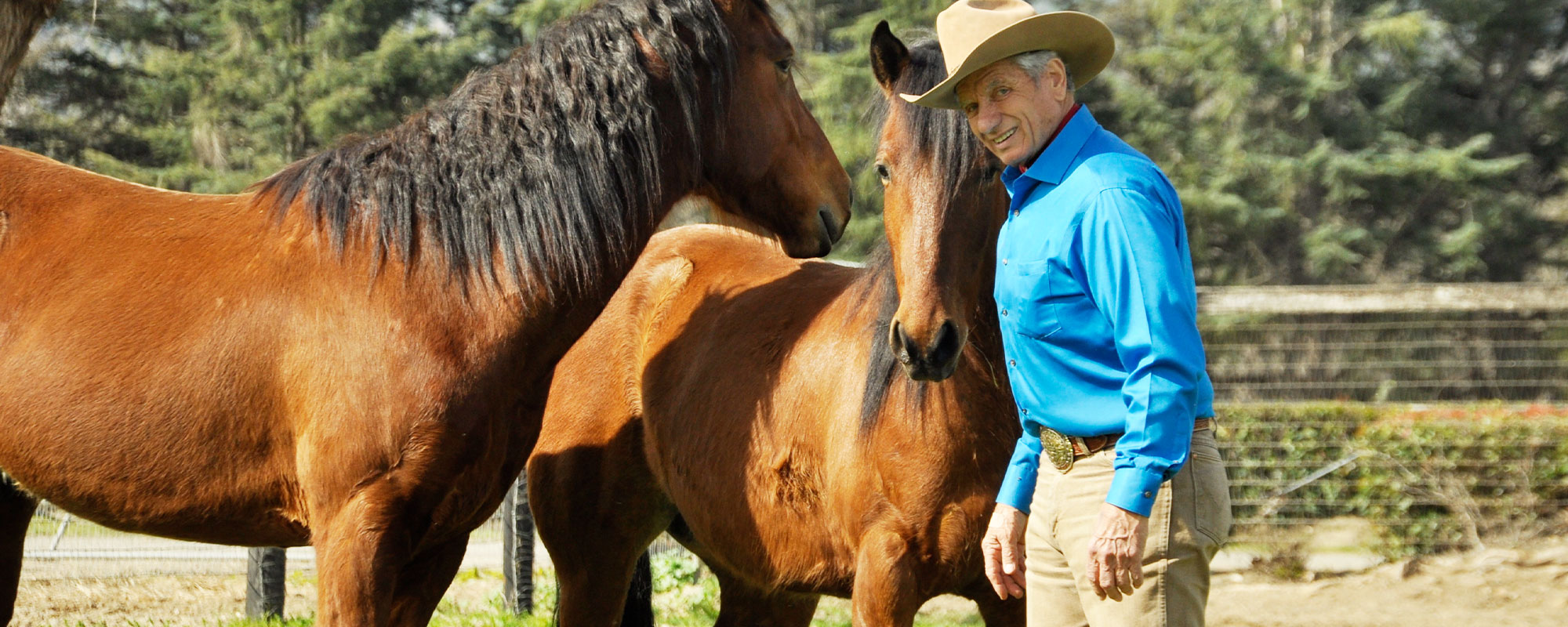
Sao Paulo, Brazil: American Trainer, Monty Roberts, is known worldwide for his gentle taming method which establishes a connection with the animal and does not require brute force.
Under the eyes of the audience at the largest event of its kind in the world, the “horse gentler” American trainer Monty Roberts took approximately one hour to tame a horse which had never been ridden, on the opening night of the Rodeo International in Barretos, Brazil.
The approximately four-year-old horse was only trained to lead before this night. The wild animal came from the Northeast territories of Brazil and the American trainer noted that he had never seen horses of this type in his life.
But he wasn’t daunted by the challenge. His gentle taming method proved, once again, to be effective, precisely opposing the aggressive methods used by his father. “My father was much harsher than any father should be,” said the trainer before starting the presentation.
His father used abusive techniques to tame the horses on the ranch where they lived in California. Unlike him, Monty Roberts never wanted to impose himself on the animal.
“I don’t want to be the boss, I want to be the partner”, he said.
Connection and Cooperation
Precisely for this reason, the trainer dedicated himself to understanding the communication system of the horses which is gestural using body language to train them. He calls this Equus and it sets up trust with the animal, creating a connection and cooperation.
To perform the presentation, the team of Certified Instructors, Brazilians Waldo Franco and Miguel Lupiano as well as German Denise Heinlein set up a round in the middle of the arena for the trainer to demonstrate his methods.
“I want Canário to be happy here”, he said of the horse.
The noise from the huge Festival Park was a factor that made the task difficult, as it scared the animal. “I would like everyone to be very quiet, but that may be impossible in Brazil”, the trainer said with a smile.
Though it was never completely quiet, the audience, or a good part of it, collaborated and even adopted the “claps” by shaking their hands instead of clapping them.
Join-Up® The Method developed by the American Monty Roberts to tame horses in a gentle way; without using violence
The taming began with a small caress on the animal’s fore head. The first phase is called the ‘Join-Up’ and starts with the trainer near the round pen’s fence, releasing the lead rope from the horse’s halter. He let Canário go freely around the pen. The aim of this stage is to gain the trust of the horse.
With his body posture, Monty Roberts was convincing the horse to travel one direction and then the other. He noted that one of the animal’s ears was “locked” on Roberts, which indicated that the animal was paying attention to the trainer. Gradually, the horse slowed down, starting to relax and lower its head toward the ground.
Soon came what the gentler explained were the main signs that the horse was relaxed: he began to lick and chew. “I’ll walk away, and he’ll follow,” said Monty Roberts. No sooner said than done. The audience began to applaud, but the trainer reminded them that it was necessary to be silent, not to scare the horse.
Desensitization
The trainer started the second part of the gentling and asked the team to bring plastic bags on a handle to carry out the desensitization process. This step consists of causing the horse to lose its fear of objects approaching it.
Monty Roberts lightly passed the object on both sides of the animal so that he understood that no violence would be used there. “It’s to show him that I mean no harm,” explained the trainer.
With the object, he simulated movements of a rider climbing and jumping on his back. Soon, Monty Roberts requested a saddle, the first of the horse’s life.
With the help of Denise Heinlein, the main instructor at the Monty Roberts method teaching center in Europe, the horse was soon saddled. The process, which usually takes a few weeks, with the American happened in minutes.
After a few laps, Monty Roberts requested light reins and a leather piece to hold the stirrups to show the horse how to follow the eventual rider’s directions. Meanwhile, the trainer walked the horse around the circle, and with each ‘cluck’ the animal trotted faster.
The First Ride
After Monty Roberts taught the rein cues, it was time for Canário to receive his first rider. The volunteer was Thiago Mega, a bucking horse champion from Barretos. He wore a helmet, at the horse gentler’s request for safety.
The rider, guided by the trainer, caressed the horse between the eyes and the trainer started to lift the rider, up and down, but not yet mounting, “To show him that climbing on won’t hurt him,” explained the American.
In a short time, Thiago was mounted on the horse. However, as expected, the horse got scared and kicked a few times. The experienced rider did not take long to see that it was time to slide off and reassure the animal.
It wasn’t time to give up. The first rider ended up being Zé, a mannequin rider made and named for the Barretos Equine Event by Monty Roberts himself. After tying Zé to the saddle, he released the animal to walk freely and to understand that none of this would hurt him.
After a few minutes with the first crash-proof rider, Thiago Mega was able to mount again and take the horse for a quiet ride around the pen, easily.
This time, it wasn’t just the horse that was delighted: the audience held back the applause until the animal exited the round pen, and then the applause was only briefly interrupted when Monty Roberts did 88 push-ups – one for each year of his life, while the audience counted along.
MONTY ROBERTS AVAILABLE FOR SELECT INTERVIEWS:
The New York Times bestselling author and world-renowned horse trainer Monty Roberts is available for interviews.
MONTY ROBERTS first gained widespread fame with the release of his New York Times Best Selling book, The Man Who Listens To Horses; a chronicle of his life and development of his non-violent horse training methods called Join-Up®.
Monty grew up on a working horse farm as a firsthand witness to traditional, often violent methods of horse training and breaking the spirit with an abusive hand. Rejecting that, he went on to win nine world’s championships in the show ring. Today, Monty’s goal is to share his message that “Violensace is never the answer.”
Roberts has been encouraged by Her Majesty Queen Elizabeth II with the award of the Membership in The Royal Victorian Order, as well as becoming Patron of Join-Up International. Other honors received were the ASPCA “Founders” award and the MSPCA George T. Angell Humanitarian Award and FEI’s Man of the Year.
Monty was recently included as Horse and Hound Magazine’s Top 50 Horsemen of All Time. Monty is credited with launching the first of its kind Equus Online University; an interactive online lesson site that is the definitive learning tool for violence-free training.
JOIN-UP philosophies can be seen at work with both humans and horses across the world, from farms to major corporations. To learn more about Monty Roberts or the many applications of his Join-Up training methods, visit www.montyroberts.com.
Horse Sense and Soldiers aired on Discovery Military in 2010 highlighting the therapeutic effect horses and Monty Roberts’ Join-Up® have on PTSD. Soon after Monty and his team developed the Horse Sense & Healing program for veterans and first responders.
Lead-Up International was officially launched worldwide at the Monty Roberts International Learning Center in Solvang, California, in February 2017. The purpose of Lead-Up International is to reduce violence in the community by creating peaceful leaders from vulnerable youth utilizing equine-assisted therapy and non-verbal communication, building trust-based relationships.
This article originally appeared on MontyRoberts.com and is published here with permission.
There are more interesting articles in our section on Clinicians & Trainers.
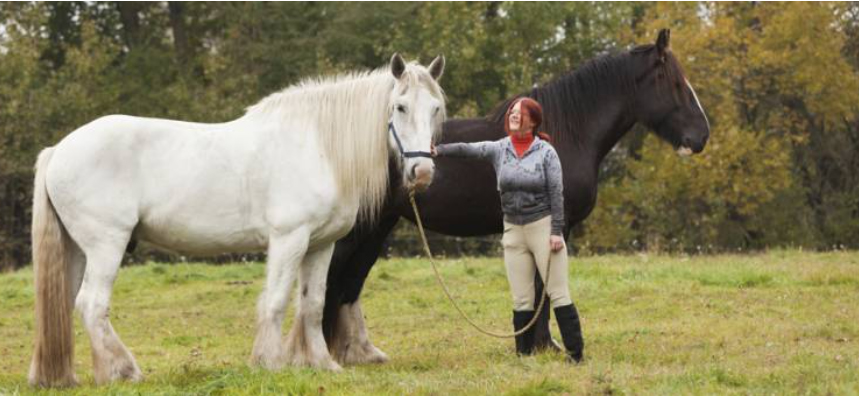
By Kentucky Equine Research Staff
A new tool, called the body condition index (BCI), provides more consistent and repeatable measures of percent body fat than traditional body condition scoring (BCS). The BCI seems particularly suited to all horse owners, even inexperienced ones.
Currently, BCS is a widely recommended tool for assessing body fat (adiposity) in horses. The Henneke scale, one of the most widely used BCS systems, ranges from 1 to 9, with horses in moderate body condition designated a score of 5. Other BCS systems use a 0-5 scale.
“Body condition scoring is subjective, which means individuals assessing the same horse may assign different scores. Most evaluators correctly identify underweight horses, but differences are observed more frequently when assessing overweight or obese horses,” explained Catherine Whitehouse, M.S., a nutrition advisor for Kentucky Equine Research.
She added, “Owners may also be reluctant to admit their horse is overweight or in a state of positive energy balance. They then assign a lower BCS to fit into the generally accepted healthy range of 5 to 6.”
Further, studies reported that many horse owners find the BCS system too technical and have only a fair ability to judge BCS even after being given instructions.
“Considering how important it is for horses to maintain optimal body condition, reliable and accurate measures of adiposity are needed,” Whitehouse said.
Using mathematical methods and morphometric measurements, researchers developed a formula that correlates to percent body fat.* They called this the body condition index, which is based on measuring heart girth, belly girth, neck circumference, height, and body length.
In other words, the BCI measures the horse’s body circumference based on simple readings from a tape measure. This is in stark contrast to relying on vision or palpation when measuring BCS, which are highly subjective.
After developing the BCI, it was then applied to large numbers of horses and ponies by both trained and inexperienced evaluators and compared to the BCS.
The main finding was that the variability of these measurements by inexperienced assessors was higher (14%) for the BCS than the BCI (11%). This means that the BCI, as an objective measure of percent body fat, should be more consistent and reproducible when performed by horse owners.
“Having a more accurate assessment of adiposity is doubly important when we consider that many owners already underestimate their horses’ body condition and that subtle changes in condition over time can be challenging to identify,” Whitehouse said.
In sum, the researchers concluded that the BCI was more consistent and reliable than BCS, particularly for the inexperienced evaluators who were final-year veterinary students and therefore considered to have comparable skill to horse owners. “Using a BCI may be more beneficial and sensitive than BCS for tracking weight gain or weight loss,” relayed Whitehouse.
Recognizing that a horse is overweight will allow management strategies to be put in place to avoid obesity-related diseases such as equine metabolic syndrome, insulin dysregulation, and hyperinsulinemia-associated laminitis.
“The key to weight loss involves reducing caloric intake while providing a complete and balanced diet. Unrestricted pasture access is usually the main reason for weight gain, followed by high-calorie forages and feeds oversupplying calories based on the horse’s life stage or workload,” Whitehouse said. “Increasing exercise in sound horses in tandem with dietary changes can also induce weight loss.”
Whitehouse added, “Effective weight-loss programs combine strict dietary management with exercise, often utilizing a highly concentrated vitamin and mineral supplement to deliver key nutrients to support health and wellness in a low-calorie form.”
Check out Body Condition Resources for more information on weight management and body condition scoring.
Read more: Body Condition Index: New Tool for Objectively Assessing Body Fat in Horses
The five amazing gaits of the Icelandic horse, including "tölt" and flying pace.
The horses of Iceland are a so-called gaited horse breed. This means that most Icelandic horses have two extra gaits to offer besides walk, trot and canter/gallop. All horse breeds have these three natural gaits and can perform them without training. The extra gaits that set the Icelandic horse apart from other breeds are called tölt and flying pace. The extra gaits are natural and new-born foals frequently show them right from the start.
TÖLT
Tölt is the unique four-beat lateral gait, that the breed is best known for. The horse’s hind legs should move well under the body and carry more of the weight on the hind end, allowing the front to rise and be free and loose. Tölt is very smooth to ride since there is no suspension between strides, as is the case in trot or canter, and it can be ridden very slowly up to a very fast speed, depending on the horse.
FLYING PACE
The flying pace is the “fifth gear”, offering a two-beat lateral movement with suspension. This gait is ridden very fast, even used for racing and only for short distances, 100-200 metres usually. Not all Icelandic horses can pace, but those that manage all five gaits well are considered the best of the breed.
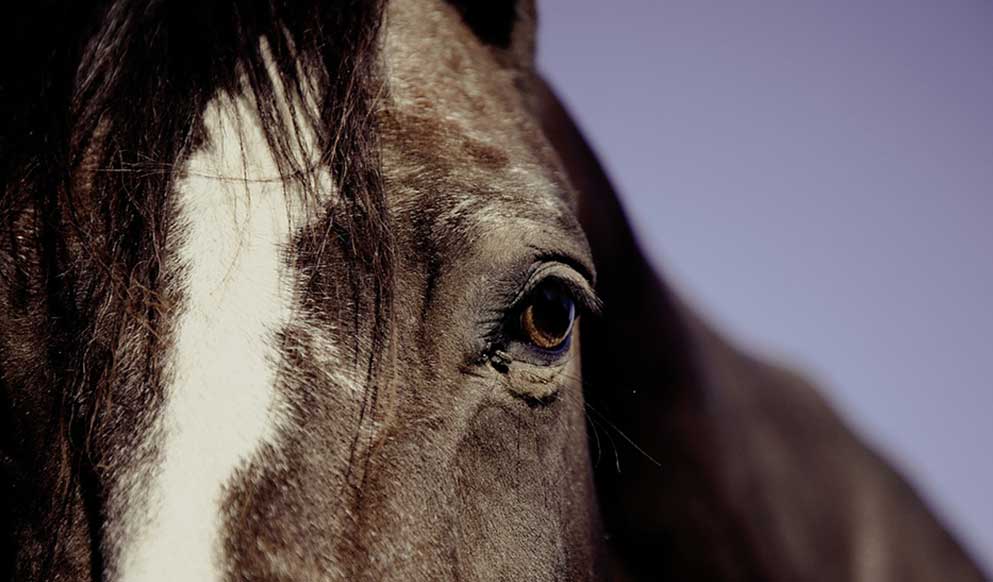
A letter from Juliet M. Getty, Ph.D.
The issue is still free choice forage feeding.
I respect and honor the way horses are made—they are different—unique, really. In a suitable, native environment, they are quite capable of taking care of themselves. They are free to eat and roam and, well, be horses.
Domestication involves removing them from their natural setting, but their instincts for survival remain unchanged, and those instincts are based on compelling physiological and mental needs. Make no mistake about this: when we ignore or deny those needs, we seriously imperil our horses.
I have very deep convictions on respecting a horse’s instincts. Common horse care practices often suppress a horse’s instinctive behaviors, forcing the horse to compromise both physiologically and psychologically. Such compromises are innately stressful, and lead to life-threatening problems like ulcers and laminitis, and undesirable—even dangerous—behaviors.
Frequently, I caution against the stress of forage restriction. Some have said that the alternative I am describing—free choice forage feeding—appears to be a road to increased obesity and an increased risk of laminitis. But they are grossly mistaken.
When we see images of wild horses running free, we all experience the hush, the chill, and the awe of their power and majesty. That is Nature at her best – allowing these incredible animals to live as they are intended.
Why is it that we don’t see our own domesticated horses in the same way? Why is it that we think we can confine them to a small area for hours at a time, give them a few “square meals” each day and expect them to be right, physically and mentally? Are they not the same horse species that long ago lived a different life?
It’s been said that our horses have become different – that horses living in the wild don’t suffer from the ravages of insulin resistance, the main cause of laminitis. Yes, it’s partly true -- we don’t see laminitis when horses are free to feed themselves. But we do see insulin resistance, and that’s actually a blessing in the wild.
Insulin resistance is the body’s way of avoiding starvation. During a harsh winter, when the food supply is sparse, horses will hold on to body fat to help them survive. They do this by having an elevated blood insulin level. When insulin is high, the cells cannot release fat. This is a survival mechanism.
We duplicate this when we restrict forage. The horse responds the same way – he is in survival mode! And he holds on to body fat.
Anything that causes insulin to rise will keep a horse fat. Hundreds of studies with humans confirm the connection between elevated insulin and obesity. Stress causes obesity in humans.
Why? Because cortisol (a stress hormone) causes insulin to rise. At the cellular level, the same is true for horses. We have equine studies to show how insulin rises during stress. So why isn’t this being extrapolated to obesity in horses?
Perhaps it’s because it doesn’t seem to make sense that eating more causes weight loss. It’s not the amount eaten but the type of food eaten that has the most impact. And we also know that starving oneself will result in weight loss (mostly muscle loss) but will slow down the metabolic rate so dramatically, that the weight comes back on with far fewer calories than it originally took to maintain one’s weight.
Yet the horse-related studies we choose to follow involve starving the horse to get him to lose weight. Which, of course, he does. And we celebrate. The conventional advice appears to work: Give the horse hay equal to 1.5% of his body weight, keep him in confined small space much of the day so he cannot graze, and he loses weight!
And if he doesn’t, reduce the amount of hay to 1%! The idiom, “not seeing the forest for the trees,” comes to mind. What is the big picture? What are you left with? A horse with less muscle mass, stressed to the max, with a sluggish metabolism so he will never live a normal life of grazing on pasture again. Never.
We have forced our horses to abandon their instincts.
They no longer get the inner signal that tells them to stop eating. To help you appreciate this, I’d like you to think about your childhood. When you were a toddler, you ate what you needed, and when you were no longer hungry, you stopped eating. Yes, you were coddled to finish your green beans, or no dessert!
So you ate more to get that reward. But your instincts (yes, you had them back then) were to eat only what your body required. As you grew, you discovered that eating has more rewards than just getting dessert; eating is comforting, it cures stress, boredom, or disappointment, and is just plain fun!
You likely don’t eat only when you’re hungry; you eat whenever you gather with friends or celebrate a special occasion. And guess what? Now that you’re grown, those instincts to eat only what your body needs have long faded.
Horses are a different story. They do not succumb to the pressures of society to influence their appetites. But when they are forced to eat on our schedules, they quickly become out of touch with that innate ability to eat slowly, a little at a time, and stop when satisfied.
Instead, they eat quickly, ravenously, with barely a breath in between each bite, because they do not know when their next meal will be available. When it gets close to feeding time they pace, bob their heads, paw the ground, and make strange noises.
This is not normal; it is a result of what we have done to our horses. We, well-meaning horse owners and caregivers, are putting our horses into survival mode!
Horses are unlike humans in one very significant way.
Their digestive tract is not the same as ours. The biology that drives the horse’s digestion is indisputable: The horse’s stomach produces acid continuously, necessitating the action of chewing to release acid-neutralizing saliva.
The digestive tract is made of muscles and needs to be exercised to prevent colic by having a steady flow of forage running through it. The cecum (the hindgut where forage is digested by billions of microbes) has both its entrance and exit at the top, thereby requiring it to be full so material can exit, lest it become impacted.
I appeal to you to look at this logically.
You should not put your horse in a dry lot or a stall with no hay. You should test your hay, make sure it is suitable for the horse (low in sugar, starch, and calories). If testing is impossible, then soak it to remove a significant amount of sugar and starch. Put it everywhere you can, encouraging your horse to take more steps to get the next bite.
Use slow feeders if you like. And think of ways to foster movement. Exercise, even a small amount, will make a difference. A larger amount will make a bigger difference.
When a horse loses weight the right way, his metabolic rate stays sound and he will be able to graze on pasture again. Perhaps you will have to limit it a bit, but maybe not. Some supplements may be helpful. I have seen hundreds of cases over the years where horses have returned to a normal life – healthy, full of vigor, with no grass restrictions.
Let your horse tell you how much he needs to eat.
Dr. Peter Morresey and Dr. Bart Barber revisit an early episode (#9) with veterinary podiatry pioneer, Dr. Scott Morrison. Learn about the advancement of equine podiatry and the creation of the Rood & Riddle podiatry department. Dr. Morrison touches on the devastating disease laminitis and what treatments have been developed to help horses try to overcome this dreaded condition.
- Time for a Change: Overwhelmed by the Pyramid? Try the Spiral!
- Three Supplements All Horses Need
- Monty Roberts' Join-Up in Brazil at the Barretos Rodeo Festival 2023 (2:54)
- Biomechanics Experiment: The Equine Spine - Neutral vs. Engaged
- What To Do If Your Horse Is Sick - A Checklist
- Good Riding Position with Ken Najorka (8:07)
- Horse Hoof Cracks 101
- Rood & Riddle Stallside Podcast - The Cost of Horse Ownership with Kate Hayes and Deb Reeder
- Equestrian Sports in Schools: Fostering Discipline, Teamwork, and Leadership Skills
- Adjusting the Rope Halter with Julie Goodnight (5:34)
- How to Safely Adjust Stirrups and Girth While Mounted on English Tack with Mitzi Summers
- Types of Western Saddles, Explained
- Know Thy Forage: Ten Forage-Related Terms That May Be New To You
- The Emergency Stop with Julie Goodnight (3:05)
- Sample Lesson on First Trot with Andrea Boone (16:49)
- Horse Heatstroke and Exhaustion
- Putting Weight on a Skinny Horse
- The Export Journey of the Icelandic Horse (22:17)
- Why Wear a Helmet? Riders Share Harrowing Close Calls
- Equine Affaire Educational Program - Monty Roberts performs Join-Up with a Wild Horse (22:37)






